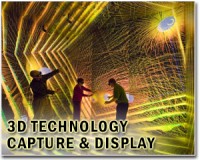 |
Albuquerque (UPI) Mar 8, 2009 International competition in three-dimensional imaging for defense applications is gathering momentum as security industry companies worldwide scramble to develop new technologies, with market forecasts that the sector will see major growth in the coming years. New technologies have focused on minimizing human contact between combatants and delivering maximum damage on the enemy without loss of lives. Three-dimensional photography, deployed in defense, is part of an overall strategy followed by military procurement agencies of governments worldwide. The one major hurdle in the way of new technologies being employed more widely by military establishments is the availability of appropriate funding and the nature of threat faced by the country, analysts said. The conflicts in Afghanistan and Iraq were a major incentive for defense industries to devise technologies that would minimize casualties and increase the offensive power of weapons deployed to deal with enemy threats. The technologies applied in warfare are also usable in corporate environments after necessary modifications, analysts said. The Boeing Co. announced Monday it has begun offering a new, compact, energy-efficient camera that provides three-dimensional images for both military and commercial applications. Boeing Directed Energy Systems and wholly owned Boeing subsidiary Spectrolab developed the camera using their own research and development funding and tested it over the past two years by attaching it to mobile ground platforms and a Boeing AH-6 Little Bird helicopter, the company said. Equipped with advanced sensors that were developed by the Massachusetts Institute of Technology's Lincoln Laboratory and transferred to Boeing under a teaming arrangement, the cube-shaped camera is one-third the size and uses 1-10th the power of most comparable 3-D imaging cameras. "Our three-dimensional camera fits a lot of capability into a small package," said Nasser Karam, vice president of Advanced Technology Products at Spectrolab. "Its compact design and modest power needs will allow it to be deployed on a wide range of platforms, including unmanned aerial and ground vehicles that don't have much room or power to spare." The camera, which Boeing can customize for each customer, has many potential uses, including mapping terrain, tracking targets and seeing through foliage. To create a 3-D image, the camera fires a short pulse of laser light, then measures the pulse's flight time to determine how far away each part of the camera's field of view is. "The camera combines cutting-edge sensor technology with Boeing's advanced pointing and tracking solutions and real-time processing to provide our customers with highly integrated 3-D imaging payloads for ground, airborne or space-based applications," said Joseph Paranto, Growth lead for Boeing's Directed Energy Systems in Albuquerque. Boeing is integrating the camera into compact 3-D imaging payloads on unmanned aerial vehicles and will test that capability this spring. The team will add 3-D video capability to the camera soon to complement its existing still-image capability. A unit of The Boeing Company, Boeing Defense, Space and Security has headquarters in St. Louis and is one of the world's largest defense, space and security businesses. Boeing Defense, Space & Security is a $34 billion business with 68,000 employees worldwide. Aside from Boeing, Fuji, Sony and others have begun marketing 3-D cameras and imaging systems and some have gone to the consumer market with a growing range of gadgetry, with the option to adjust the technology for corporate and defense uses. Analysts said the propagation of three-dimensional imaging meant a major upheaval and overhaul of security systems in place in commercial, government and public use. It also meant that both government and corporate sectors worldwide would need to allocate larger funds to modernize and replace imaging systems employed in defense and security, right down to surveillance equipment in public places.
Share This Article With Planet Earth
Related Links Space Technology News - Applications and Research
 'Avatar' inspires a high-tech fair in glorious 3D
'Avatar' inspires a high-tech fair in glorious 3DHanover, Germany (AFP) March 4, 2010 Hot on the heels of the stunning success of James Cameron's 3D adventure "Avatar," the world's top high-tech fair this year was definitely best viewed through 3D glasses. "It's completely crazy this year. 3D is all everyone's talking about," said visitor Amanda Grossbauer, 52, as she peered hesitantly through her special glasses at a 3D display at the CeBIT fair in northern Germany. Alth ... read more |
|
| The content herein, unless otherwise known to be public domain, are Copyright 1995-2010 - SpaceDaily. AFP and UPI Wire Stories are copyright Agence France-Presse and United Press International. ESA Portal Reports are copyright European Space Agency. All NASA sourced material is public domain. Additional copyrights may apply in whole or part to other bona fide parties. Advertising does not imply endorsement,agreement or approval of any opinions, statements or information provided by SpaceDaily on any Web page published or hosted by SpaceDaily. Privacy Statement |